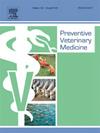Advisers’ perception of biosecurity implementation on large-scale poultry farms in Europe
IF 2.4
2区 农林科学
Q1 VETERINARY SCIENCES
引用次数: 0
Abstract
Biosecurity is a fundamental preventive tool to control animal infectious diseases. The relationship between advisers and farmers plays a key role in determining farmers’ compliance with on-farm biosecurity measures (BMs). The aims of this survey were (1) to provide an overview on the implementation of biosecurity in European poultry farms as declared by the advisers and (2) to better understand advisers’ perception of the reasons why farmers do not comply with biosecurity rules and pinpoint potential obstacles to their implementation. One hundred and fifty-seven advisers working in various poultry sectors (breeders, enclosed and free-range layers, enclosed and free-range meat poultry) were interviewed to give their opinion on the implementation of 62 BMs. The advisers’ replies (n = 6485) on the implementation of BMs were reported as “always” (67.6 %), “sometimes” (19.8 %) and “never” (8.1 %) implemented. The advisers from the local governmental institutions declared a significantly lower percentage of “always implemented” replies (62 %) than those from other categories (producer organisations (73.7 %), companies (73.8 %) and veterinary clinics (67 %)). Regardless of the poultry sector, the most commonly implemented BMs declared by the advisers were the “daily surveillance of birds”, “flock register”, “rodent control” and “feed storage protection”. The BMs declared as the least commonly implemented were “visitors and personnel showering before entering the poultry house” for all the surveyed productions and “personnel hand washing” for all the production types except breeders. Some hygiene practices were also declared to be poorly implemented in most of the surveyed productions such as the “cleaning/disinfection of the rendering tank after each collection”, the “presence of concrete area around the house”, the “use of separate material for the poultry house” and the “restriction of domestic animals entering the site” and especially in meat poultry “the bacterial self-check of the house” and “the cleaning/disinfection of the feed silo between each flock”. According to the advisers ‘reports, the reasons why farmers do not comply with biosecurity on their farm were insufficient knowledge of biosecurity issues (“not enough training” 12.3 % and “not enough advice” 8.5 %), low awareness of the expected benefits (“no known advantages” 14 % and “not useful” 4.6 %), the lack of time (17.8 %), financial issues (16.8 %) and the unsuitability of the measures (17.4 %). This study highlighted, from the European advisers ’point of view, the shortcomings of the implementation of biosecurity on poultry farms and a room of improvement requiring adapted and tailored support measures for a better biosecurity compliance.
顾问对欧洲大型家禽养殖场实施生物安全的看法
生物安全是控制动物传染病的基本预防手段。顾问和农民之间的关系在决定农民是否遵守农场生物安全措施(BMs)方面起着关键作用。本调查的目的是:(1)概述顾问所宣布的欧洲家禽养殖场生物安全实施情况;(2)更好地了解顾问对农民不遵守生物安全规则的原因的看法,并指出实施生物安全规则的潜在障碍。我们采访了157名在不同家禽行业工作的顾问(饲养员、圈养和散养蛋鸡、圈养和散养肉禽),就62项管理措施的实施发表了意见。顾问对实施管理指标的答复(n = 6485)报告为“总是”(67.6% %)、“有时”(19.8% %)和“从不”(8.1 %)。来自地方政府机构的顾问宣布,“始终执行”答复的百分比(62% %)明显低于其他类别(生产者组织(73.7 %)、公司(73.8 %)和兽医诊所(67 %))。无论家禽行业如何,顾问们宣布的最普遍实施的基础管理措施是“鸟类日常监测”、“禽群登记”、“啮齿动物控制”和“饲料储存保护”。在所有被调查的家禽养殖场中,最不常执行的家禽管理措施是“访客和工作人员在进入家禽养殖场前洗澡”,而在除饲养者外的所有养殖场中,最不常执行的是“人员洗手”。在大多数被调查的产品中,一些卫生措施也被宣布执行得很差,例如“每次收集后对呈现池进行清洁/消毒”,“房屋周围有混凝土区域”,“家禽舍使用单独的材料”和“限制家畜进入现场”,特别是在肉禽中“房屋细菌自检”和“每群之间的饲料仓的清洁/消毒”。根据顾问的报告,农民不遵守农场生物安全的原因是对生物安全问题的了解不足(“培训不足”12.3 %和“建议不足”8.5 %),对预期效益的认识不高(“没有已知的优势”14 %和“没有用”4.6 %),缺乏时间(17.8 %),财务问题(16.8 %)和措施不合适(17.4 %)。从欧洲顾问的角度来看,这项研究强调了在家禽养殖场实施生物安全的缺点,以及需要适应和量身定制的支持措施以更好地遵守生物安全的改进空间。
本文章由计算机程序翻译,如有差异,请以英文原文为准。
求助全文
约1分钟内获得全文
求助全文
来源期刊

Preventive veterinary medicine
农林科学-兽医学
CiteScore
5.60
自引率
7.70%
发文量
184
审稿时长
3 months
期刊介绍:
Preventive Veterinary Medicine is one of the leading international resources for scientific reports on animal health programs and preventive veterinary medicine. The journal follows the guidelines for standardizing and strengthening the reporting of biomedical research which are available from the CONSORT, MOOSE, PRISMA, REFLECT, STARD, and STROBE statements. The journal focuses on:
Epidemiology of health events relevant to domestic and wild animals;
Economic impacts of epidemic and endemic animal and zoonotic diseases;
Latest methods and approaches in veterinary epidemiology;
Disease and infection control or eradication measures;
The "One Health" concept and the relationships between veterinary medicine, human health, animal-production systems, and the environment;
Development of new techniques in surveillance systems and diagnosis;
Evaluation and control of diseases in animal populations.
 求助内容:
求助内容: 应助结果提醒方式:
应助结果提醒方式:


